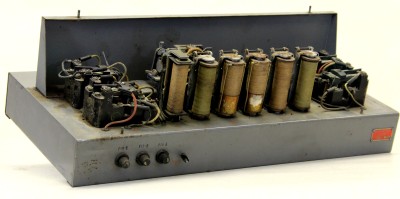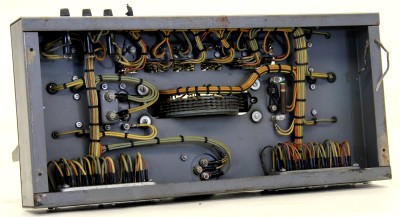Feb-15 ⋅⋅⋅
233D Transmitter Restoration Project
We presented the attached PP at the Rockwell Collins Retiree Volunteers session yesterday morning. Lawrence did the heavy lifting on the slide show and all I did was remove his Keats labels and add a couple of notes and pages. (Interesting that an accomplished System Engineer also had an English Lit minor! Good show Lawrence!) I think we got a few folks hooked at the presentation, but I didn’t get them reeled in yet, so hopefully that can happen in the next couple of weeks. Rod is pretty much saturated with the Fifi project for the next two weeks as is Jules. He and Jules are also planning to work with Bill Carns of the CCA next week on some museum and Autotune projects. Bill has promised to provide some advice on the cosmetics issues related the 233D, so that will be of great interest because he has been involved with a number restoration projects. The cart is very useful and we put some miles on it yesterday, mostly related to Rod’s Fifi project, but it will serve to transport some of the heavy chassis from the power supply. We now have both the RF and Modulator bay cabinets completely stripped. We commandeered a cabinet and a couple of file cabinets near the “back door” by the steps that goes upstairs to FS engineering. FS had cleared them out but they said there were no plans to move them so we could use for the project. I’ll get some official looking labels printed for them so we can keep the space. Using the cabinet and files will free up bench space for us and Rod stored the spare 450TL there to help protect it. Rod also talked to Mike Barton and found that he is now working for DCMA, so that was the reason we couldn’t find him in the system. I’ve established a “cocked eyed” optimist schedule that will serve as goals, but without any guarantees: - March 15 (this year): All three racks/cabinets and the 2 end panels ready to send out to a TBD vendor for cleanup/repair as required. We should have all the subassemblies pulled from the power supply bay in the next two weeks. We will need to come up with a method of protecting the cabling and connectors that remain in the cabinet. I want to avoid removing the cable, but that may be necessary. - April 15 (after taxes): Complete cleanup and checkout of Tone Control chassis and Telco relay chassis and build a temporary interconnect cable between to the two units to begin Autotune checkout. We will also need to provide operating power for the two assemblies so we need to determine power supply requirements. I have a fairly portable 0 to 320 volt, 1.5 amp supply that we can use for the plates, if we don’t want to the supply from the mod bay. I think the filament transformers are on the tone control chassis. - June 1: Cabinets returned to the museum we start system cabling continuity testing. - June 15: Complete continuity testing and start re installing chassis in the racks. - July 1: Connect single phase 220 power to the RF and modulator bays. Apply filament voltage to everything except the 450TLs. - July 15: Apply low voltage to all stages of the modulator and RF bays. - August 1: Complete necessary power supply connection to allow the exciter to generate RF. -August 15: Complete the connection from the exciter to the PA Grid network and attempt to generate a fair amount of carrier and attempt to key the carrier to allow a CW contact. I hoped we might find a way to modulate the exciter so we could do a low power contact with Fifi, but that doesn’t seem likely. - October 15: Complete the installation of the final PA and modulator tubes and attempt to operate the transmitter at reduced power. The last owner claimed it would be possible to operate the transmitter at reduced power when using single phase AC. Haven’t found anything in the documentation to support that, but it may be possible. Conduct on the air tests with Fifi until she completes the schedule for the year. - February 15, 2014: Complete the restoration and conduct full power tests. This assumes there are no major failures of difficult to find parts. It also assumes the availability of 3 phase power in the room. At this point the only available drop in the room is for 400Hz and it is likely that even that power is not available. We would need single phase 220 by July 1, but the Autotune drive motor may require 3 ph power. I have a small 3 phase power supply (100 VA, I think) but I haven’t had it on for several years, and I don’t know if will still work. It will likely require a few hundred tasks to complete the schedule. Many will be easy and quick, but I can think of several that will require quite a lot of time. We will also need some funding to finish some of the tasks. I have about $150 “invested”so far in tools, copying and deOxit but have no problem donating that because that’s cheaper than some of the other sources of entertainment and it keeps me out of beer joints, pretty much. My wife likes getting me out of the house to work on the project, but when she audits the petty cash drawer, she gets a little owly. I’m going to meet with Dick Siefers Monday afternoon on another project, so I’ll try to remember to take my checkbook and my museum club membership app, so I’ll be a full fledged, card carrying member and won’t have to sneak into the club meeting. Jim |
||
|
||
| February 15, 2013 |

